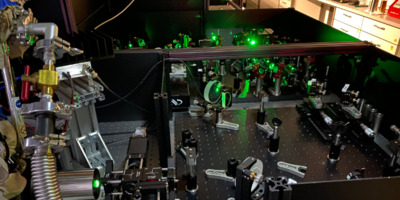Discovery in 2D devices reveals hidden cavities

In the right combinations and conditions, two-dimensional materials can host intriguing and potentially valuable quantum phases, like superconductivity and unique forms of magnetism. Why they occur, and how they can be controlled, is of considerable interest among physicists and engineers.
Research published in Nature Physics has revealed a previously hidden feature that could explain how and why enigmatic quantum phases emerge.
Using a new terahertz (THz) spectroscopic technique, the researchers revealed that tiny stacks of 2D materials, found in research labs around the world, can naturally form what are known as cavities. These cavities confine light and electrons into even tinier spaces, potentially changing their behaviour in drastic ways.
“We’ve uncovered a hidden layer of control in quantum materials and opened a path to shaping light–matter interactions in ways that could help us both understand exotic phases of matter and ultimately harness them for future quantum technologies,” said James McIver, assistant professor of physics at Columbia and lead author of the paper.
The discovery began in Hamburg, when McIver was a group leader at the Max Planck Institute for the Structure and Dynamics of Matter (MPSD). Researchers are interested in what happens when stable systems are thrown out of balance. The McIver lab turned to light.
“2D materials, with their fascinating macroscopic properties, often behave like black boxes. By shining light on them, we can literally shed light on the hidden behaviour of their electrons, revealing details that would otherwise remain unseen,” said Gunda Kipp, a PhD student at MPSD working with the McIver group and first author of the publication.
The challenge is that the wavelengths of light needed to probe 2D materials are much larger than the materials themselves, which are typically smaller than a human hair. They saw unexpected standing waves.
“Light can couple to electrons to form hybrid light–matter quasiparticles. These quasiparticles move as waves and, under certain conditions, they can become confined, much like the standing wave on a guitar string that produces a distinct note,” said MPSD postdoctoral fellow and co-first-author Hope Bretscher.
In the case of the guitar, the string’s fixed ends define the boundaries for the standing wave; holding your fingers on the strings shortens the wave at which a string can vibrate, changing the note it produces. In optics, a similar effect can be achieved with two mirrors, which trap light between them and create a confined standing wave inside what is known as a cavity. When a material is placed between the mirrors, the light reflected back and forth will interact with it, potentially changing its properties.
But mirrors may be optional.
“We found that the material’s own edges already act as mirrors,” Kipp said. With their THz spectroscope, they observed that excited streams of electrons reflect off the edges to form a type of hybrid light–matter quasiparticle called a plasmon polariton.
The McIver lab studied a device made up of multiple layers, each of which can act as a cavity separated by a few tens of nanometres. The plasmons that form in each layer can, in turn, interact — often strongly. “It’s like connecting two guitar strings; once linked, the note changes. In our case, it changes drastically,” Bretscher said.
The next question is what exactly determines the frequencies of the vibrating quasiparticles and how strongly the light and material interact.
“With co-author and MPSD postdoctoral fellow Marios Michael, we developed an analytical theory that only needed a handful of geometric sample parameters to match the observations of our experiments,” Kipp said. “With just a click of a button, our theory can extract the properties of a material and will help us design and tailor future samples to obtain specific properties. For example, by tracking resonances as functions of carrier density, temperature or magnetic field, we may uncover the mechanisms driving different quantum phases.”
While the published work captured plasmons, the new chip-scale THz spectroscope should be able to observe other kinds of quasiparticles oscillating within a wide variety of 2D materials. The team is already at work measuring new samples.
“This whole project was a bit of a serendipitous discovery. We didn’t expect to see these cavity effects, but we’re excited to use them to manipulate phenomena in quantum materials going forward. And now that we have a technique to see them, we’re intrigued to learn how they might be affecting other materials and phases,” Bretscher said.
Mechanical strain boosts lead-free ferroelectrics
Scientists have discovered a way to boost the performance of lead-free ferroelectrics using pure...
Engineers build longer-lasting qubit
Researchers have developed a superconducting qubit that operates for over one millisecond,...
Crypto chip keeps water flowing in rural communities
Twisthink has integrated Microchip's ATECC608B crypto chip into an IoT pump sensor, to...







